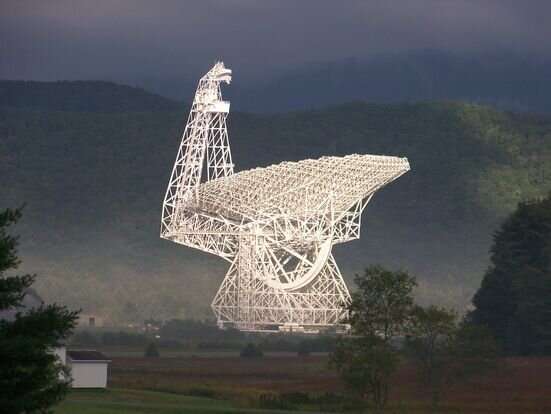Einstein wins again

An international team of researchers from 10 countries has conducted a 16-year long experiment to challenge Einstein's theory of general relativity with some of the most rigorous tests yet. This team includes West Virginia University professors Maura McLaughlin and Duncan Lorimer (pictured below). Their study of a unique pair of extreme stars, so called pulsars, involved seven radio telescopes across the globe, including West Virginia's Green Bank Telescope (GBT), and revealed relativistic effects that were expected and have now been observed for the first time. Einstein's theory, which was conceived when neither these types of extreme stars nor the techniques used to study them could be imagined, makes testable predictions that agree with the observations at a level of at least 99.99%.
More than 100 years after Albert Einstein presented his theory of gravity, as part of the established scientific method researchers around the world continue their efforts to find flaws in general relativity (GR). The observation of any deviation from GR would constitute a major discovery that would open a window on new physics beyond our current theoretical understanding of the Universe.
The Cosmic Laboratory
The research team's leader, Prof. Michael Kramer from the Max Planck Institute for Radio Astronomy in Bonn, Germany, says: "We studied a system of compact stars that is an unrivaled laboratory to test gravity theories in the presence of very strong gravitational fields. To our delight we were able to test a cornerstone of Einstein's theory, the energy carried by gravitational waves, with a precision that is 25 times better than with the Nobel-Prize winning Hulse-Taylor pulsar, and 1000 times better than currently possible with gravitational wave detectors." He explains that the observations are not only in agreement with the theory, "but we were also able to see effects that could not be studied before."Prof. Ingrid Stairs from the University of British Columbia at Vancouver gives an example: "We follow the propagation of radio photons emitted from a cosmic lighthouse, a pulsar, and track their motion in the strong gravitational field of a companion pulsar. We see for the first time how the light is not only delayed due to a strong curvature of spacetime around the companion, but also that the light is deflected by a small angle of 0.04 degrees that we can detect. Never before has such an experiment been conducted in a regime with such a high spacetime curvature."
This cosmic laboratory is known as the "Double Pulsar".
Both McLaughlin and Lorimer were part of the team that discovered the double pulsar system in 2003. Since the discovery, they and their students have been involved in studies of numerous aspects of the system ever since. A focal point of research in the Center for Gravitational Waves and Cosmology, pulsar astronomy research continues to expand our knowledge into the Universe. McLaughlin explains "Our results are nicely complementary to other experimental studies, including gravitational-wave detectors such as LIGO, which test gravity in other conditions or see different effects. Over the very long timeline of our experiments, we've been able to measure many effects not measurable in any other system or through any other technique."
A Double Pulsar: what does it mean?
The double pulsar system consists of two radio pulsars which orbit each other in just 147 min with velocities of about 1 million km/h. One pulsar is spinning very fast, about 44 times a second. The companion is (in astronomical terms) relatively young and has a rotation period of 2.8 seconds. The motion of the two pulsars around each other makes them an almost perfect laboratory for tests of gravity.
Seven radio telescopes from around the world were used as key observational tools in the study.
Among the seven radio telescopes was the National Science Foundation's Green Bank Telescope (GBT) in Green Bank, West Virginia.
The GBT has provided monthly observations of the system for roughly 14 years. With its 100 meter diameter and state-of-the-art receivers, it is the cornerstone of the observational campaign, as it provides more sensitive timing observations than any other telescope. Lorimer emphasizes that "since there is not enough time available on a single telescope to carry out the necessary observations, it is vital that different telescopes contribute to the study, however this makes the analysis extremely complex as the data must be combined with nanosecond precision."
This research was funded by National Science Foundation award 1517003.
The results are published in APS Physical Review: https://journals.aps.org/prx/abstract/10.1103/PhysRevX.11.041050
More information:
M. Kramer et al, Strong-Field Gravity Tests with the Double Pulsar, Physical Review X (2021). DOI: 10.1103/PhysRevX.11.041050
Provided by West Virginia University